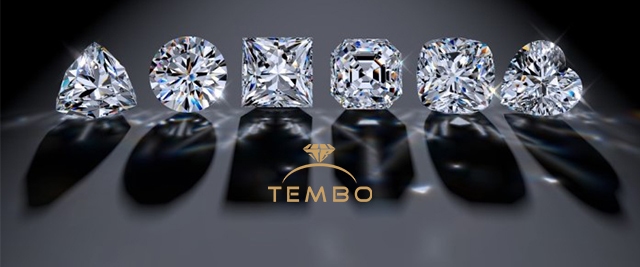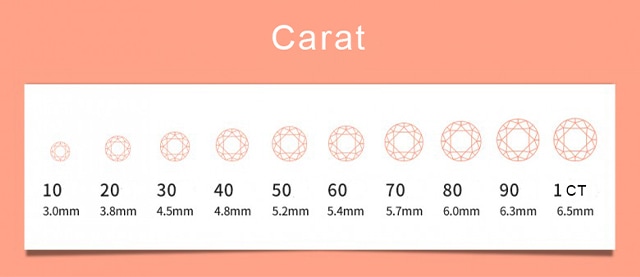Basic overview
The so-called ‘4C’ are short for the four words beginning with the C, referring to the diamond’s CARAT WEIGHT, CLARITY, COLOUR, and CUT. By combining the four points of the “4C”, it is easy to understand the value and quality of a diamond. In terms of value for money, there must be a number of priorities when choosing a bare drill. When determining the size, the first suggestion is to consider cutting, cutting quality directly affects the fire color of the diamond, so people often say that cutting is the second life of the diamond. Second, consider the color. The color starts from D to Z. The closer it is to d, the stronger the penetration, and the brighter the color after refraction and dispersion. It is recommended to finally consider the transparency of the diamond, which is better at vs and above levels as transparency has little impact on the diamond. Want to see clean and immaculate with the naked eye only, won’t affect the beauty of a diamond. The most influential factor in the base price of a diamond is the weight of the 4C, which is also the most accurate standard in the world. It is the weight of the carat. The greater the weight of the carat, the rarer the mass, and therefore the rarer and more expensive it is.

Diamond 4C parameters
CARAT WEIGHT

Weight (Caratage) in carats. 1 carat =200 mg =0.2 g. A carat is divided into one hundred parts, and each part is called a cent. 0.75 carat also known as 75 minutes, 0.01 carat for 1 minute.
CLARITY

Diamonds crystallize in mantle magma deep inside the Earth in a complex environment with a variety of ingredients and high temperatures and pressures. After hundreds of millions of years of geological change, it is inevitable that there are all kinds of sundries or defects in its interior. The color, number, size, location, and distribution of these inclusions have different effects on the transparency of the diamond. Clarity of diamonds 10 magnifying glasses are usually used to classify the internal and surface defects of diamonds and their effect on brightness. According to the National Inspection Standards of China, the clarity of non-set diamonds is divided into 10 grades: LC, VVS1, VVS2, VS1, VS2, SI1, SI2, P1, P2, and P3. Set diamonds are classified into five grades: excellent, very good, good, fair, and average. Class P drill is also known as class I drill. Class P diamonds are not usually used as gemstones, so they are usually classified only as class P and are no longer classified as P1\P2\P3.
COLOUR

Diamonds come in a variety of natural colors, from the precious colorless (white when cut and ground), the rare light blue and pink, to the common pale yellow. The more transparent, the more colorless, the more transparent the white, the more bright the color after refraction and dispersion. The whitest diamond is rated D (i.e. starting with the first letter of the diamond). Diamond colors are divided into 11 grades, arranged alphabetically from D to Z, with D being the best.
CUT

Diamond cutting refers to the precision of its cutting grinding ratio and the perfection of the completion of modification. Good cutting should reflect the brightness and fire of the diamond as much as possible, and try to maintain the weight of the raw stone. From high to low, GIA’s cutting grade is Excellent, VeryGood, Good, Fair, and Poor.
Founder of the Diamond 4C Standard
GIA was founded in 1931 in Los Angeles by RobertM.Shipley, founder of the Gemological Institute of America. Initially, GIA trained jewelers to assess wholesale prices through night classes and correspondence courses. In 1953, the GIA opened its first laboratory in New York and began publishing diamond appraisal reports. Two more LABS formally called GemTradeLaboratory.INC. (GTL), were established in Santa Monica, Calif., and downtown Los Angeles. GTL was part of the GIA, and specialized expertise did not include an evaluation. GIA is a non-profit organization supported by leading American jewelers and celebrities. It is an identity and research organization shared by JEWELLers in the US and its subsidiary GTL provides identity services for clients. Up to now, GIA has 14 teaching institutions around the world, providing professional research, sales, evaluation, and other courses, training high-quality jewelry practitioners, which also contributes to GIA’s high reputation in the industry.
The importance of diamond 4C
The weight of the diamond is the easiest feature to measure in the 4C. Like other precious stones, diamonds are measured in carats.
Cutting determines the brightness, fire, and flash of the diamond. There is no single measurement standard for diamond cutting, but a range of related criteria are combined with observational data such as the light color, size, and finish of the diamond. Most jewelry experts agree that cutting is the most important quality of a diamond because even if a diamond has perfect color and clarity, it will be overshadowed if it is not cut well. The higher the cut grade, the more brilliant the flame color and brightness of the diamond, the more attractive the appearance, so the price increases accordingly.
After the cut, color is the most important diamond feature when buying a diamond. When looking at a diamond, the human eye first notices the cut and then the color of the diamond. Color is especially important when considering buying a larger diamond, because the larger the diamond, the more light it reflects, the easier it is to notice the color.
Unless it is a large diamond, the transparency level has little effect on the visible appearance of the diamond. The larger the diamond, the larger the cross-section, which will increase the visibility of the clarity. Transparency is considered the least important feature in the 4C standard for diamonds, as the brightness of a diamond is mainly determined by the cut. The higher the level of the diamond cut, the harder it is to find the parcel.